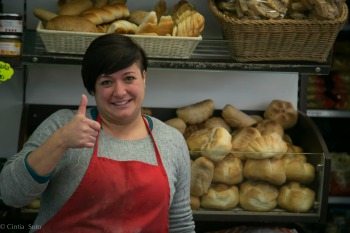Rome’s Delicious Mercato Testaccio, the Market He Loves

By John Henderson
If you want off the beaten path in a city like Rome, where the paths have been beaten for two millenniums, follow your nose.
Follow the smell of salmon caught that morning, of maroon prosciutto taunting you behind glass, of white, round buffalo mozzarella floating in its own juices.
Follow your nose to Mercato Testaccio. If the neighborhood of Testaccio is the true Rome, Mercato Testaccio is Rome’s true public food market.
A Daily Stop
It is my home away from home. It is my daily stop after the gym across the Tiber River. I retired to Rome seven years ago, and ever since moving to this neighborhood visiting Mercato Testaccio has become as habit-forming as checking my mail.
The neighborhood, located about two miles south of the Roman Forum, has a food history that dates back to the Roman Empire. Testaccio was the emperors’ port, where olive oil, wine, grain, and other foodstuffs were shipped up the river from the nearby Tyrrhenian Sea.
It remained a working-class neighborhood all through the 19th century when it was Rome’s major slaughterhouse. Workers were paid in animal parts, the poorest parts an animal could unwillingly give.
And, to this day, those animal parts remain a staple in the market and in neighborhood trattorias.
Tripe (cow’s stomach tissue), pajata (cooked intestine of a milk-fed calf), coda alla vaccinara (oxtail), baccala’ (cod, the cheapest fish in the ocean). All these disgusting trademark dishes can be found in numerous stands in Mercato Testaccio.
True Roman street food, as they call it, is based on a dare.
However, all the glorious foods that have made Italian cuisine famous are in the market, located exactly four minutes from my apartment. Ironically, I must pass through the old slaughterhouse to reach it.
Today its remains share grounds with a music college. So in walking past giant meat hooks hanging from the sides of abandoned buildings and the sounds of saxophones and pianos, you get Roman history with a soundtrack.
Nuova Mercato
The official name is Nuova Mercato di Testaccio. That’s in deference to the original Mercato di Testaccio. That market slung tomatoes and pork for nearly 100 years a few blocks away until it moved to this site in Aug. 2012.
It doesn’t have nearly the atmosphere but when you’re swooning over a meal you just cooked with the food you bought here, who really cares?
Shopping in Italy is different. The food is so fresh and natural, I shop in the Mercato Testaccio every day for what I’ll eat that day. Supermarkets are safety nets in case I can’t make the market before it boards up at 1:30 p.m.
My local supermarket looks like something out of rural Eastern Europe in the ‘60s.
Dingy lighting with dodgy meat wrapped in cellophane and random, cheap boxed goods stacked on dusty shelves.
I figure if I don’t make my market by 1:30, I’ll eat like a peasant.
A Market Routine
I have my usual routine at Mercato Testaccio. It’s a circuitous route among the 100-plus stalls that begin with cheap clothes and household goods on one end and goes to fresh produce and meat on the other.
In the middle sits a thriving coffee bar where neighborhood women gossip over foamy cappuccinos, a half dozen brown plastic food bags at their feet.
I first wind my way to Federico, my butcher. He always wears a white fedora, similar to the ones every tourist buys and instantly labeling them a tourist from two blocks away. He once told me he wears it, not to resemble an accountant from Santa Monica but to honor the macellaios (Italian for butchers) who have been wearing them in Rome for centuries.
Prosciutto and Sausage Specialty
He also honors them by selling the best prosciutto and sweet Italian sausage I’ve ever had. His prosciutto is the maroon color of a New York filet. His sausage is so lean I don’t need to drain the fat from my pan. I can’t have an aperitivo or make my prized pasta salsiccia (sausage) without a visit to Federico. His meats are almost health food. I’m in about the best of my life and his meats are a reason.
Fresh Bread?
Next, I turn around to Alessandra in her bread stand. Eating bread in Italy is tricky. It is so fresh, you buy it at 9 a.m. and it’s stale by 5 p.m. Meanwhile, your average loaf of bread in the U.S. has the shelf life of Ivory soap. I’ve heard various strategies here. Wrap it in a brown paper bag and put it in the fridge. Freeze it, then pull it out two hours before you eat it.
Just Buy More Bread
It’s all too much of a hassle. Just buy it, eat it and enjoy it. Alessandra, whose perpetual smile brightens everyone’s mood, sees me coming and immediately puts a round bun of “pane latte sesamo” (soft sesame bun) in a brown bag, like Pavlov’s dog hearing a bell.
I then go across the aisle to the vegetable stand where pretty Paola sells me tomatoes so sweet I eat them like apples.
They go in my pasta sauce, my salads, my antipasti mix. If there was tomato rehab, I’d enter it. She sells clementines that explode in your mouth with cold, fresh juice after being in my fridge for two hours.
A fruit trick I learned from Mussolini’s biography. He did it to help a sour stomach; I do it as a thirst quencher. Unlike the U.S. where red peppers are three times the price of green, her reds are the same price as the green, the yellow, and the orange. They all turn a simple salad into a rainbow of healthy goodness.
A few steps away stands Alessandro, my pasta guy. As bald as a mushroom, Alessandro stands behind trays of about a dozen different kinds of pasta. Salmon-filled ravioli. Orechiette. Fettuccini. Tortellini. All handmade that morning.
All beat the boxed pasta I ate in the United States for decades. Fresh pasta may be Italy’s most perfect food.
Cook fresh pasta of any kind (There are more than 300 varieties, according to Rome’s pasta museum. Yes, it does have one.), brown some garlic, add some fresh tomatoes and a dash of oil then cover it with grated Parmigiano Reggiano.
You’ve got a simple cheap meal that would sell for $15 in the U.S.
The Cheese Goddesses
Next down the walkway are the cheese goddesses, Antonella and Francesca, the attractive mother-daughter team whom I mistook for sisters.
They get bufala mozzarella shipped up from Campania, the region famous for Naples and the best bufala in Italy.
The white balls sit in murky fluid in a big bowl atop the counter. Cut up a ball onto a sliced tomato and drizzle it with extra virgin olive oil and you have one of the best afternoon snacks of your life.
About once a week I visit the fish stall. I can tell how important food is to Italians by going to fish stalls. That’s where a big, husky fishmonger covered in blood and holding a cleaning knife the size of a machete will painstakingly tell me how to delicately season a salmon. The guy looks like a gladiator and talks like Paula Deen.
Eating from the Market
People ask me how I can afford being retired in Rome. It’s easy. I eat five or six days a week out of this market. I rarely spend more than 10 euros a day. I can pay for a gourmet Italian meal I make myself for about 7. And I’ve never felt healthier.
I’d write more but the market closes in 90 minutes. And I’m hungry.
Eurail Passes: What to Know about Buying a Europe Train Pass
- Tropea: The Gem of Calabria - July 20, 2023
- Istanbul’s Fascinating Hippie Travelers’ Pudding Shop - May 20, 2023
- Malta is Popular for Making Movies - September 2, 2022





